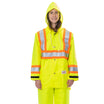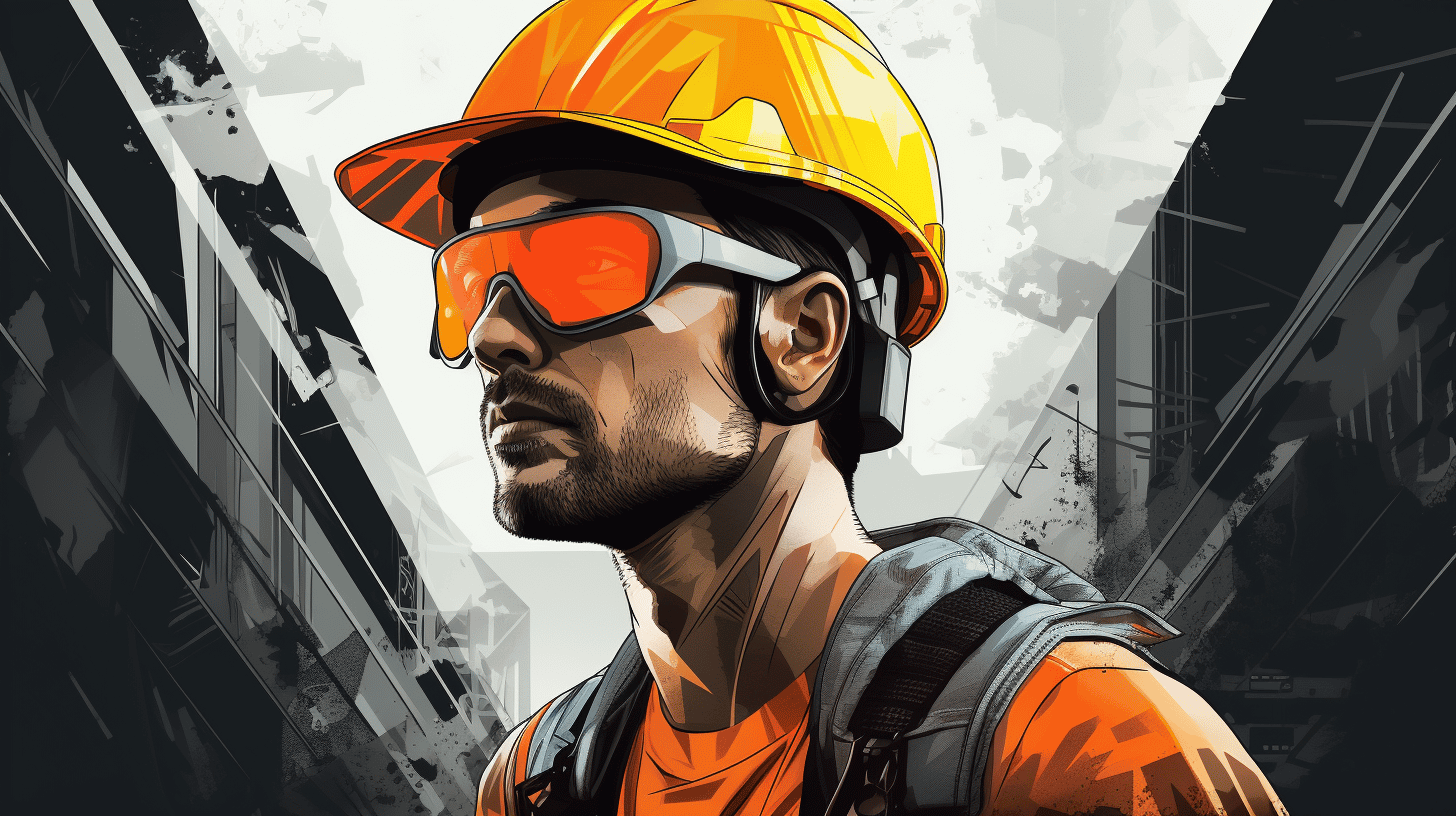Welcome to a comprehensive guide crafted with construction workers in mind, focused solely on promoting health and safety at the workplace. The construction industry is a vital artery of any economy, giving life to infrastructural projects and buildings that mold our skyline. However, it's also an environment inherently fraught with potential hazards, which can, unfortunately, result in accidents and injuries, or, in severe cases, fatalities.
This article serves as an imperative reminder of the importance of safety within this dynamic field. We'll explore in-depth the statistics of construction injuries and fatalities, giving you a clear view of the potential risks. We'll highlight the importance of protecting yourself from noise exposure, discuss the burgeoning construction worker safety market, underline the importance of complying with safety standards, and emphasize the critical role effective communication plays in maintaining a safe environment. Finally, we'll share with you five handpicked safety tips, shoring up your defenses against diverse potential pitfalls in the construction industry. So roll up your sleeves, put on that hard hat, and let's dive into the world of construction safety.
Understanding Construction Injuries and Fatalities
As the spine to socio-economic development, the construction industry is filled with numerous risks and threats. One of the major concerns is the high injury and fatality rates among workers, becoming an area that requires immediate attention and proactive interventions. This article will delve into the frequency of construction injuries, the fatalities witnessed in the industry, and the commonplace root causes of these tragedies.
Frequency of Injuries
The risk spectrum associated with the construction industry magnifies the frequency of injuries recorded on jobsites. Higher injury rates are unfortunately a common occurrence, with 6% of those injuries severe enough to require workers to miss work. The severity of these injuries not only undermines the health and wellbeing of the workers but also impacts the productivity and progress of construction projects. In the fiscal year of 2022/2023, specifically, there were 4,038 reported non-fatal injuries, primarily due to slips, trips, and falls.
Fatalities in the Construction Industry
In addition to injuries, the construction industry also witnesses a high number of fatalities. In fact, the sector is responsible for nearly 20% of all workplace deaths, with 1,092 fatalities recorded in the year 2022 alone. Staggeringly, the fatality rate for workers in this industry stands at approximately 9.6 deaths per 100,000 full-time equivalent workers.
The high risk and hazardous nature of construction work is further exemplified by the fact that 1 in 5 deaths among U.S. workers occur in the sector. Additionally, it is estimated that construction professionals have a 1-in-200 chance of suffering a fatal injury over a 45-year career. This statistic underlines the immediate need for preventive measures and safety protocols.
Common Causes of Injuries
Now let's dig a bit deeper into the root causes of these alarming statistics. A substantial 38.4% of construction-related deaths are attributed to falls, slips, and trips. Unsound scaffolding, inadequate safety gear, unguarded steel rebars or unsecure ladders, all contribute to these avoidable incidents.
Taking into account these insights, it becomes clear that urgent, sector-wide safety improvements are needed. Not only are these steps necessary to protect the workforce that drives the industry, but they are also crucial for maintaining productivity and progress in construction. Through improved training, regular site inspections, and rigorous implementation of safety protocols, we can create a safer, healthier construction domain. After all, every worker deserves a safe environment to build our world.
Noise Exposure Risks in Construction
In construction, the glaring risks of physical injuries often overshadow the less visible, but just as significant, health hazards. One such unseen menace is hazardous noise exposure, a peril hiding in plain sight or, more appropriately, hiding in plain sound. Prolonged exposure to excessive noise in construction sites poses severe threats to workers' auditory health, with potential ramifications extending far beyond.
In 2023, a startling revelation came to light - more than half of construction workers were exposed to dangerous noise levels, demonstrative of the alarming prevalence of this issue. However, the repercussions of noise exposure don't end at discomfort or temporary hearing loss; they may escalate to permanent, debilitating conditions such as tinnitus, a persistent ringing or buzzing in the ears.
Consider this: approximately 7% of construction workers suffer from tinnitus. This percentage might seem small — just a sliver when compared to the entirety of the construction workforce. But dig deeper, that's thousands of lives burdened with an avoidable ailment, thousands of individuals experiencing difficulties in concentrating, communicating, or even completing daily tasks due to a constant buzzing backdrop.
The risk of noise exposure isn't uniform throughout a construction site. Various factors, such as the proximity to noise-emitting equipment, duration of exposure, and even individual susceptibility, orchestrate to determine the level of risk exposed.
Given the gravity of these statistics, what can be done to mitigate these risks? These solutions may help:
- Regular noise level assessments: Frequent monitoring can keep tabs on noise levels and identify hazardous areas.
- Use of quieter equipment: Where possible, opting for equipment designed to operate at lower noise levels can make a world of difference.
- Personal protective equipment (PPE): Ear plugs or noise-cancelling headphones can significantly reduce the noise exposure for workers.
- Health education: Empowering workers with knowledge of their risks and rights can go a long way in stress management and prevention.
The severity of this issue necessitates immediate attention and a proactive approach. Beyond the implications for individual workers, reducing noise exposure risks can drastically enhance the overall safety and productivity of construction sites.
Investing in protective measures and prioritizing workers' health isn't just good ethics; it's good business. After all, the sweetest sound in any construction project is the harmonious blend of safety, productivity, and progress.
The Construction Worker Safety Market
Embracing safety in the construction industry is more than just a compliance measure - it's a life-saving initiative. As a result, a whole market has sprung up around construction worker safety, driven by the ongoing need to keep workers safe amid the rigors of construction tasks. This section will explore the fascinating dynamics of the construction worker safety market.
The construction worker safety market is one that is influenced by a wide range of factors. Government regulations, technological advancements, and an increased awareness of the need for comprehensive safety measures are all major contributors to its growth. In fact, as of 2023, this market was valued at a whopping $2.95 billion and growth is projected to continue.
But what exactly falls in this category? Well, think safety helmets, high visibility clothes, reflective jackets, rain gear, and even safety boots. Each of these items plays a vital role in ensuring that workers are safe as they undertake construction activities.
Let's take rain gear as an example. The quality of rain gear is a critical factor in the safety measures of a construction site. A Transforming Safety in Construction article notes, bad rain gear can make things slippery, increasing the risk of accidents. On the other hand, good quality rain gear is designed with anti-slip properties, making workers safer even in wet conditions.
This significant and consistent investment in safety gears is indicative of the importance of safety in the construction industry. It's a sign that industry stakeholders are willing to prioritize safety over costs, and it's also a testament to the fact that safe construction sites are more productive and less costly in the long run, offering incentives far beyond compliance.
So next time you pass a construction site, take a moment to appreciate the importance of safety in construction and the vast market that supports it. Who knows, you might just spot a worker in high-quality rain gear, symbolizing the $2.95 billion market that places a premium on safety.
Importance of Compliance with Safety Standards
In today's dynamic construction industry, safety cannot be overlooked. Adherence to safety standards is not just an ethical obligation—it's a legal one too. The gravity of this matter is reflected in data released by the Occupational Safety and Health Administration (OSHA). Shocking as it may sound, between October 2022 and September 2023, OSHA reported a staggering 28,778 total citations and executed 11,641 inspections, all uniquely linked to construction. Such alarming figures indicate a pressing need for higher compliance with safety norms and spurs us to delve deeper into the significance of these safety standards.
Safety regulations safeguard the welfare and wellbeing of construction workers—the backbone of any construction project. These rules play a critical role in:
- Preventing accidents and injuries: Equipping workers with protective gear and adhering to established safety procedures can significantly reduce work-related accidents and injuries.
- Enhancing productivity: A safe working environment boosts morale, reduces absenteeism, and enhances overall productivity.
- Avoiding lawsuit and penalties: Compliance with safety standards helps companies avoid hefty fines and legal consequences imposed by regulatory bodies.
The consequences of non-compliance—beyond hefty fines and legal repercussions—also include potential harm to the company's reputation and trustworthiness. Clients and customers today prioritize safety, taking note of past incidents and companies' responses to them.
Compliance with safety standards is not an area to be compromised. In this fast-paced industry where projects and targets often eclipse concerns for safety standards, it's vital to step back and reassess. Adherence to these regulations does more than just protect workers—it reinforces the company's values and commitment to its employees.
Respecting the safety protocol is a sign of a responsible, diligent, and proactive business. It's high time we gave compliance its due recognition, for it delineates the line between a safe, productive work environment and a hazardous one. Remember, safety isn't just a checkbox but a commitment—a social contract, if you will—ensuring the protection of everyone involved. Our future depends on it. By prioritizing safety, we are not just protecting lives today but also inspiring a safer construction industry for tomorrow.
Effective Communication in Construction Safety
In the bustling, dynamic environment of a construction site, safety should be everyone's prime concern. Make no mistake, the charges of handling heavy equipment, ascending towering scaffoldings, and exposing oneself to harmful elements are not for the faint-hearted. It demands precision, alertness, and most importantly, effective communication.
That's right! Clear, concise, and coherent communication plays a pivotal role in the construction setting. It's not just about shouting out orders or sending occasional incident updates. Effective communication in construction safety embodies a culture of shared responsibility, where every cog in the machine is aware of its role and the roles of others.
Employers bear a significant part of this duty. They are obliged to craft an open environment that encourages employees to voice their concerns about potential hazards on the job site without fear of retaliation. It's crucial to listen. Remember, those on the ground are the first to experience and identify risks. Their insights are not only valuable but could spell the difference between a regular day at work and a disastrous accident.
Broadly, effective communication in construction safety can take several forms:
- Safety Training: Regular and comprehensive safety training can equip workers with the necessary knowledge to recognize and mitigate hazards. This training should also emphasize the importance of communication and teamwork in maintaining a safe environment.
- Written Policies and Procedures: Clearly described, easily accessible protocols guide workers on how to act in the face of danger. These documents should be regularly updated and communicated to the entire team.
- Regular Safety Meetings: Meeting regularly to discuss safety updates, relay information about potential hazards, and allow workers to share concerns fosters an atmosphere of mutual trust and cooperation.
- Incident Reporting: Promoting an open culture of reporting near misses or incidents without fear of punishment ensures potential hazards are addressed quickly and appropriately.
"Employers must never miss the boat on creating opportunities for their employees to share their observations on safety management. The feedback from those in the front lines is priceless," notes one industry expert.
In essence, when communication is effective, each team member understands their role within the grand safety scheme, from the newest laborer on-site to the seasoned project manager. They know their voices matter and their safety is everyone's business. With this reassuring knowledge, every worker can contribute to a fulfilling and safe construction site experience.
Top 5 Safety Tips for Construction Workers
Delving into the world of construction, it's noticeable how the whirring of machines, the banging of heavy metals, and the bustling activities can leave an exhilarating yet dangerous setting. It's an environment filled with potential hazards, making it essential to arm yourself with the best practices for maintaining safety. As the saying goes, "It's better to be safe than sorry."
Tip 1
On top of the list is the use of appropriate protective gear. From hard hats to safety glasses, gloves to high-visibility vests, using the right gear can significantly reduce the risk of injury. It's equally vital to purchase quality items to guarantee the maximum protection possible, ensuring your gear passes the vital 'durability test.' This Guide for Construction Workers provides an insightful read into making the best purchasing decision.
Tip 2
Getting to know the worksite is another critical measure towards guaranteeing safety. It involves becoming familiar with the general layout, understanding the location of safety equipment or emergency exits, and identifying potential security risks. A proper understanding of your environment can help prevent accidents before they occur.
Tip 3
Training cannot be overemphasized in a construction worksite. Construction workers should receive thorough and continuous training on the safe handling of tools and equipment, and the procedures to follow in the event of an emergency. A well-trained employee is an asset to any organization, but even more so in the field of construction.
Tip 4
Adhering to safety protocols is vital in maintaining a secure work environment. These guidelines are put in place to keep workers safe, and disregarding them can lead to severe consequences. Whether it's respecting the instructions on machinery operation, or following the correct procedure when working at heights, remembering and sticking to the rules is non-negotiable.
Tip 5
Lastly, maintaining a healthy physical and mental state is fundamental. Construction work can be physically demanding, therefore, staying fit and taking care of oneself is vital. It includes observing regular breaks, maintaining a balanced diet, and ensuring a sufficient amount of sleep.
When people think of the construction industry, they often focus on the creation of magnificent structures. However, without diligent attention to safety protocols, these marvels may come at the cost of workers' health and wellbeing. For that reason, consider these five safety tips as a construction worker's toolbox for survival, protection, and success on the job site.
Conclusion
In the challenging world of construction, safety should always be recognized as a paramount factor. For a construction worker, a clear comprehension of the risks involved and a robust commitment to adhering to safety measures can be the ticket to a long and prosperous career free from debilitating accidents. It's necessary to ensure that top-notch safety equipment like Rain Gear Pro's chainsaw safety pants are incorporated into their daily routine.
Made with the industry's finest material and upheld with utmost attention to detail, Rain Gear Pro's safety pants are truly leading the way in protective work apparel. This gear is designed thoughtfully to face common issues such as crotch blowout, meaning workers don’t have to compromise their safety and comfort while on site.
When construction workers prioritize safety, job sites become safer places for everyone involved. Above all, an industry that cares for its worker's welfare will do more than just build structures — it builds trust, reliability, and enduring professional relationships.
Frequently Asked Questions
-
What are the top 5 safety tips for construction workers?
The top 5 safety tips for construction workers are: 1. Always wear appropriate personal protective equipment (PPE), 2. Follow safety guidelines and procedures, 3. Use proper lifting techniques to prevent strains and injuries, 4. Be aware of your surroundings and potential hazards, and 5. Take regular breaks to avoid fatigue and maintain focus.
-
Why is wearing PPE important for construction workers?
Wearing personal protective equipment (PPE) is crucial for construction workers as it helps protect them from potential hazards such as falling objects, flying debris, chemical spills, noise pollution, and more. It reduces the risk of injuries and ensures their safety on the job.
-
How can construction workers stay updated with safety guidelines and procedures?
Construction workers can stay updated with safety guidelines and procedures by attending regular safety trainings, workshops, and seminars. They should also read and understand safety manuals, follow safety signage, and communicate with supervisors and colleagues about potential risks and safety measures.
-
Why is it important to use proper lifting techniques in construction?
Using proper lifting techniques is important in construction to prevent strains, back injuries, and other musculoskeletal problems. Workers should lift with their legs, not their back, maintain a straight posture, and avoid lifting heavy objects alone whenever possible, using lifting equipment or seeking assistance when necessary.
-
What are some common hazards in construction and how can workers avoid them?
Common hazards in construction include falls from heights, electrical hazards, equipment malfunction, exposure to harmful substances, and more. Workers can avoid these hazards by wearing fall protection gear, following electrical safety protocols, performing regular equipment inspections, using appropriate ventilation and respiratory protection, and staying vigilant and cautious.
























Leave a comment
This site is protected by hCaptcha and the hCaptcha Privacy Policy and Terms of Service apply.